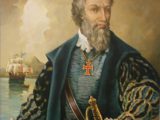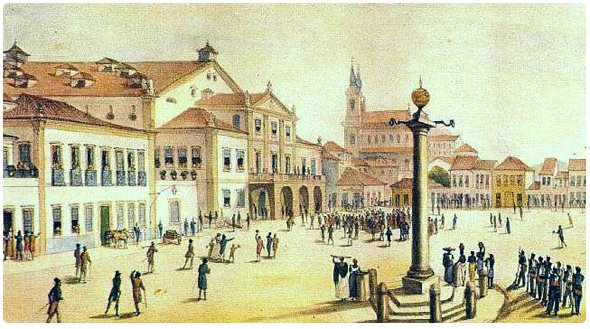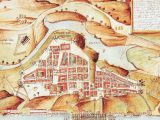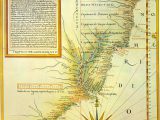Este post também está disponível em:
Português
English

The history of Bahia began with the arrival of the Portuguese in Porto Seguro and then with colonization, the empire and the republic.
The official history of Brazil began in Bahia; history records that the discoverer, Pedro Álvares Cabral, landed on the shores of the region where Porto Seguro is today, on the southern coast of Bahia.
It is possible that the messenger ship sent by Cabral to tell King Manuel I of the new lands discovered (at first it was thought that an island had been discovered, which was named Ilha de Santa Cruz) traveled along the coast of Bahia from Porto Seguro to the north, before setting off across the Atlantic towards Portugal.
The first official records of the history of Bahia and the region of Salvador, however, were made by the expedition of 1501; Américo Vespúcio, who took part in the expedition, was the first to speak of the bay they called “de Todos os Santos”, because it was found on November 1, All Saints’ Day.
The name “Bahia” would spread to the territory that was formed with the lands of the hereditary captaincies donated to Francisco Pereira Coutinho, Pero de Campos Tourinho, Jorge de Figueiredo Correia, D. Antônio de Ataíde and D. Álvaro da Costa.

History of Bahia in colonization, empire and republic
From the occupation of Salvador and its surroundings, in the first two governments, there were very clear distinctions between Salvador (and the region bordering the bay, called the recôncavo) and the more distant interior.
Despite the excellence of the anchorage discovered in 1501, the Portuguese abandoned it in the first two decades of the colony’s existence, allowing the French to trade with the natives there.

This abandonment explains the surprise of Pero Lopes de Sousa, whose voyage dates back to 1530, when he found the legendary Caramuru in Bahia, who had been living among the savages since he was shipwrecked in 1510 or 1511.
The captaincies on the central coast of Brazil offered no prospects of return, which is why they were destined for the less wealthy of the grantees; the captaincies that attracted the most attention were those in the far north (near the mouth of the Amazon) and the far south (near the mouth of the River Plate) and for the same reason: the rivers gave easy access to the interior of Brazil, where, it was thought, rich gold and platinum mines could be found, just like on the west coast of America.

For this reason too, the captaincies did not prosper; the grantees had few human, material and financial resources and depended on aid from the Crown; the Crown, seeing no prospect of an immediate return, sent little aid to the captains.
To replace the failed regime of captaincies, King João III decided to install a government-general, based in Bahia, which, although located at unequal distances from the extremes of the coast occupied by the Portuguese, offered good conditions for giving “favor and help to the other captaincies and for dispensing justice, providing for the affairs of the royal treasury and the good of the parties”.
Tomé de Sousa was appointed to carry out this policy. According to the regiment of December 17, 1548, he was to build “a fortress and a large and strong settlement in a convenient place”.
After violent wars against the Indians of Jaguaripe and Paraguaçu (1558 and 1559), the possession of Matuim and Passé was concluded.
The incorporation of the hinterlands into Bahia was not only completed with cattle droves and corrals, but also with wars against the amoipiras, acroás and paiaias Indians.
Religion also played an important role; Rome sent the first bishop of the Americas, Bishop Sardinha, to Salvador, and the religious missions of the priests of the Society of Jesus and the friars of San Francisco and Mount Carmel contributed greatly to the civilizing, productive and constant activities.
Another stimulus for settlement was the discovery of gold in the Serra de Jacobina.
In the 18th century, Bahia had 77,000 inhabitants. Accompanying the conquest of the territory on the one hand, and corresponding to Portugal’s orientation on the other, four production zones were characterized: (1) the Recôncavo, for sugar cane; (2) Jaguaripe and Camamu, for manioc flour; (3) tabuleiros or areais, for tobacco and manioc; (4) the sertão, for cattle.
The main characteristic of the economy, not just of Bahia but of the whole of colonial Brazil, was that it was geared towards the foreign market, with the lands of Bahia placed as suppliers of raw materials and tropical farming items that were of interest to Europe.
Established under the constraints of the mercantile economy, the export economy was based on slave labor.
However, it developed in a varied and complex way, with a longer and more expressive list of articles and products, such as brazilwood, sugar, cotton, tobacco, gold, wood, raw leather, cachaça and flour.
History of Bahia during the Dutch occupation
Serious events interrupted the tide of prosperity reigning in Bahia at the beginning of the 17th century.
Not only as a result of the union of the Portuguese and Spanish crowns (Spain forbade Brazil to trade with Holland), but also thanks to the greed aroused by the wealth of sugar, Holland decided to attack Bahia in 1623.

In May 1624, the squadron commanded by Jacob Willekens arrived in Salvador, with 26 ships and 500 fire hydrants under its command. The invaders easily occupied the city, remaining there for a year, until they were repulsed by the Portuguese-Spanish armada, commanded by D. Fradique de Toledo Osório.
Unhappy with the loss of the metropolis, the Dutch returned to it in 1638, when they were already firmly established in Pernambuco, taken in 1630 (see History of Pernambuco).
This time, the attack was led by Maurício de Nassau, who, having begun the siege on April 16, withdrew, beaten, on May 29. The Count of Bagnuolo commanded the defense.
It can be seen that the Dutch presence in Bahia was shorter and left fewer traces than in Pernambuco.
After the storm of these invasions, which seriously compromised local production, Bahia resumed its previous progress.
History of Bahia in the struggle for Independence
At the end of the 18th century, there were 164 merchants in Salvador, both exporters and importers.
All the trade was destined for Europe, Africa, Rio Grande do Sul and the ports of the Plata. However, in the political, social and economic structure that had been defined at the time, there were several conflicts between those born and living in the captaincy and the authorities who exercised government on behalf of the king of Portugal.
In the cases of the so-called Maneta riot (October 1711) and the Terço Velho uprising (May 1728), the insurgents failed to locate the main cause of Bahia’s difficulties and problems in its status as a colony; By the time of the sedition in 1798, known as the Bahian Conjuration or the Tailors’ Conjuration, the condition of colony appeared as the main cause of the monopoly on trade, the fixed price for sugar, tobacco, cotton and sole, the extortionate collection of taxes, the tiny pay of the military, and there was already a demand for a political regime capable of guaranteeing equal rights for all, without distinction of color or social origin.
Even after the headquarters of the Portuguese colonial empire moved to Rio de Janeiro in 1763, Salvador continued to stand out as a political center of influence, where groups of patriots, military and civilians would end up starting the fight to separate Brazil from the metropolis.
These groups were involved in the 1817 rebellion in Pernambuco, and in February 1821 they promoted Bahia’s adherence to the constitutionalist movement, which abolished the absolute monarchy in Portugal.
However, as the liberal-constitutionalists in Lisbon were clearly opposed to Brazil’s interests, finally agreeing to the military occupation of Salvador by Portuguese soldiers and sailors (February 1822), the struggle for independence in Bahia evolved into a slow and painful war.
The conflict began with the “25th of June” in Cachoeira in 1822 and accumulated heroic episodes, among which the battle of Pirajá on November 8, 1822 stands out.
The year 1823 arrived with repeated and new battles in the Bay of All Saints and around Salvador.
Having quickly overcome the disagreement between the French military officer Pedro Labatut and the Brazilian military in command of the army, Colonel José Joaquim de Lima e Silva, Viscount of Majé, ordered the broad offensive on June 3, which ended up forcing the Portuguese troops to withdraw.
On July 2, 1823, Bahia celebrated the Brazilian victory; to this day, July 2 is a holiday in Bahia, celebrated with as much reverence as September 7. When the fighting began in the province, the Bahian Maria Quitéria formed a women’s company, which fought throughout the war.
History of Bahia in the empire
After the separation, Bahia’s support for the national demand for the union of all the provinces into a single country did not prevent the federalist movements of 1832 and 1833, linked to the name of Captain Bernardo Miguel Guanais Mineiro, and that of 1837, better known as Sabinada, from the name of its leader, the doctor and journalist Sabino Vieira.
In its military form, the Sabinada lasted four months, extending into the hinterland (Feira de Santana and Vila da Barra), with some very violent fighting.
Other aspects of the instability of socio-political structures at this time were the various slave uprisings (the most serious was that of the black Muslims, the Revolt of the Males, in 1835), the circulation of counterfeit coins, and family feuds, examples of which were those that bloodied the São Francisco, between the Guerreiro and Militão families.
In 1843, the diamond regions of the Açuruá mountain range were discovered. Successive plans repeated the demand for efficient means of communication to the Recôncavo and the sertão. Inaugurated precariously in 1819, steam navigation extended its lines to the river towns (Santo Amaro, Cachoeira, Nazaré) and the sea towns on the south coast (Camamu, Ilhéus).
In 1853, the government signed the first contract to build the Bahia-São Francisco railroad, which, along with the Alagoinhas-Itabaiana, Central, Santo Amaro-Bom Jardim and Nazaré-Santo Antônio railroads, formed Bahia’s rail network in the 19th century.
There was also a concern to improve sugar cane farming and sugar production, and some planters introduced new qualities of cane and some mills adopted steam engines. An example of this is the large sugar mill that Francisco Gonçalves Martins set up in 1859.
As early as 1841, a company had been founded in Bahia to introduce useful factories. With the abolition of the slave trade and the subsequent decline in trade with Africa, many merchants associated their capital with the founding of banks, savings banks and insurance companies.
Accompanying this growth in economic activity, administrations generally sought to expand schooling opportunities and systematize teaching and education.
Nevertheless, the crises in the price of sugar on the foreign market, the competition that diamonds from South Africa began to pose in Lavras, the difficulties in adapting free labor to an economy that had been based on slave labor for centuries, the terrible health and hygiene conditions in the most concentrated urban centers and the lack of financial resources led the province to the vexatious situation that was outlined in the great crisis of 1873.
Sugar prices did not compensate for the raw material consumed; commercial transactions came to a standstill. Economic and financial decay was evident. However, it was in relative political tranquillity that Bahia took part in the abolitionist movement (1888) and the proclamation of the republic (1889).
History of Bahia in the Republic
In Bahia, the republic was proclaimed by Colonel Frederico Cristiano Buys on November 16, 1889.
Councillor José Luís de Almeida Couto governed the province, and its commander in arms was the old marshal from Alagoas and future President Hermes Ernesto da Fonseca, whose monarchist convictions were well known.
As soon as the first news came from the court, on the morning of the 15th, various monarchist politicians, both liberal and conservative, adopted the idea of mounting armed resistance to the new regime.
Ahead of the initiatives, Colonel Buys, an officer of great prestige, summoned the republican leader Virgílio Clímaco Damásio to the São Pedro fort and, with him and others, proclaimed the republic at six o’clock on the afternoon of the 16th.
As they were doing so, Marshal Hermes joined in, informing the officers and troops of his decision, since the Emperor and Princess Isabel had left the country to travel to Europe.
In a telegram, Rui Barbosa, Minister of Finance in the provisional government, had announced the appointment of Manuel Vitorino Pereira as governor of the state, to the detriment of the Republican Virgílio Damásio; Vitorino was a professor at the medical school and a liberal politician with a federalist tendency, and would be another Bahian who would later assume the Presidency of the Republic, albeit briefly. Colonel Buys was in favor of appointing Damásio, the oldest and most consistent Republican leader.
Unhappy with this rise of the former liberals, some remnants of the Conservative Party took part in the episodes that led to the resignation of Governor Manuel Vitorino (April 1890) and the appointment of Marshal Hermes da Fonseca to govern Bahia.
This was followed by the drafting of the state’s first constitution, the choice of José Gonçalves da Silva in an indirect election, his deposition during the political crisis of November 1891, and the appointment of Rear Admiral Leal Ferreira.
It was a confusing phase, although it was possible to follow the slow assimilation of monarchist politicians into the new regime, some of whom even went on to occupy posts in the state administration. The first directly elected governor was the doctor Joaquim Manuel Rodrigues Lima (1892-1896).
During the administration of his successor, Councillor Luís Viana (1896-1900), the bloody episode of Canudos took place, a conflict of serious proportions that revealed to coastal Brazil the painful situation of poverty and cultural backwardness in the sertão.
From the end of the 19th century to the beginning of the 20th, the export economy took off again. The cocoa plantation, which was always expanding, came to represent 20% of the state’s budget, as well as growing in the general movement of the country’s exports as a producer of foreign currency. This led to a series of industrialization initiatives.
In 1904, 141 factories and manufactories were registered, including 12 spinning and weaving mills, three shoe factories, 12 cigar factories, four beer factories, two chocolate factories and five iron foundries.
With the funds obtained, the administrations of Severino Vieira (1900-1904) and José Marcelino de Sousa (1904-1908) improved river and sea navigation, railroads and highways.
João Ferreira de Araújo Pinho (1908-1911) tried to follow the same line, but never finished his term in office and was forced to resign in a climate of misunderstanding and petty political infighting.
With the majority of the state chamber, under the command of José Joaquim Seabra, then Minister of Transport during Hermes da Fonseca’s four-year presidency, having refused his legal replacement (Aurélio Viana), two acts of defiance against federal power followed: the occupation of the state chamber building and the decree transferring the state capital to Jequié.
The federal government responded with military action, which culminated in the bombing of Salvador on January 10, 1912.
From that date until 1916, Seabra was in office. He urbanized the city of Salvador, maintaining the same style of political dissent as his predecessor, always personal and confrontational between oligarchic groups.
The next administration, that of Antônio Muniz de Aragão (1916-1920) was marked by the revolt in the backlands.
A Democrat who was fiercely opposed by the anti-seabrists, Muniz de Aragão was nevertheless able to continue the administrative program inaugurated by his predecessor.
Seabra tried to get elected for a second term in office in 1920, but ran into strong opposition from politicians linked to Rui Barbosa.
That’s when what was called at the time the “war of the sertão against the capital” broke out, a revolt simulated in telegrams and newspaper headlines, but which demonstrated the enormous power of some landowning colonels, men who commanded hundreds of heavily armed jagunços.
In February 1920, the government of Epitácio Pessoa decreed intervention in the state, carried out by General Cardoso de Aguiar.
At the time, Bahia’s large export-import trade, linked to sugar cane, coffee, tobacco and cocoa plantations, relied solely on foreign companies and a few more or less subsidized national ones.
During the First World War, coffee and tobacco were restricted by the interruption of trade with Germany.
German companies or companies with German capital gave way to other companies with English and American capital. This, however, did not change the mechanism that had been in place since the end of the 19th century: crops were produced on a consignment basis, with harvests previously sold to exporters.
Thus, the world crisis of 1929 hit Bahia hard.
Cocoa exports fell from 70,000 tons to 63,000; tobacco from 26,500 to 26,200; and coffee from 25,000 to 19,000.
In the small industrial park, there were only nine textile factories with a total of 700 looms and 1,600 workers. It was paralleled by the textile and sugar industries, represented by 16 mills.
Large areas of land were occupied by cattle, goats and sheep. A regular production of furs was exported to the United States.
History of Bahia in the 1930 revolution and modernization
In the 1930 elections, Bahia gave its candidate for vice-president of the republic on the official ticket, the former governor Vital Soares, but there had already been conspiracies in the state in 1929, during the Liberal Alliance campaign.
While passing through Salvador in April 1929, Juarez Távora had left instructions about the movement that broke out in October of the following year.
It is undeniable that Bahia resisted the 1930 revolution, which is why there was a kind of military occupation in the first two years of the decade.
With the intervention of Lieutenant, then Captain, Juracy Magalhães (1931-1935), the situation changed, so that his constitutional election really did correspond to a new political framework.
Juracy Magalhães gave support and encouragement to cocoa and tobacco plantations, industry and livestock farming, defining some of the planning perspectives that would be expanded in the 1950s and 1960s.
However, on November 10, 1937, Getúlio Vargas established the Estado Novo. Rejecting the coup, Juraci Magalhães preferred to resign the same day and return to the barracks.
With the Second World War over and Brazil returning to constitutional political institutions, the Social Democratic Party (PSD) and the National Democratic Union (UDN), in coalition, elected the liberal Otávio Mangabeira, a former foreign minister in the Washington Luís government, as governor.
Mangabeira took Bahia back to where it had left off before the Estado Novo and introduced a program of reforms.
However, modernization only really began in the 1950s, when the state government promoted economic planning, and its milestones were the Landulfo Alves refinery, the Paulo Afonso hydroelectric plant and the Rio-Bahia highway.
Several campaigns led to increases in Petrobras royalties and tax incentives for industry.
History of Bahia’s industrialization
In the 1960s, Bahia’s economic growth accelerated with the creation of the Aratu industrial center (cement, metallurgical plants) and the promotion of agriculture in the São Francisco basin, which in the following decade was fostered by the São Francisco Valley Development Company (Codevasf).
One of the people most responsible for the modernization of Bahia was the controversial Antônio Carlos Magalhães, who held important political positions in the state and in the country; Magalhães used his political strength to direct investments to Bahia.
Bahia’s industrial development gained enormous momentum with the Camaçari petrochemical complex, inaugurated in 1978. At the same time, tourism also began to gain strength as a source of wealth.
In the 1990s, the cocoa plantation in the south of Bahia, another economic mainstay of the state, was hit by the crisis caused by the spread of witches’ broom, a plague that led to a substantial drop in production and high unemployment. In 1997, the Companhia de Eletricidade da Bahia (Coelba) was privatized.
Bahia.ws is the largest travel and tourism guide to Bahia and Salvador.
History of Bahia – Salvador da Bahia has 450 years of history



















